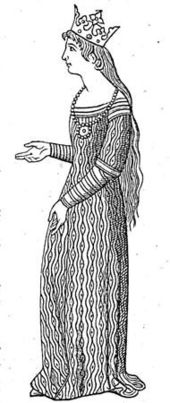Surcot
The surcot (also Sorket , Sorkeit , Middle High German Sûrcôt from the French surcot , Sorcos , Sorquaine , Sobrecot , Cotte hardie [ 'kɔt aʀ'diː ]) was a sleeved tunic in the Middle Ages that both sexes and all classes wore. The name comes from the fact that it was worn over the cotte . A sleeveless surcot was also called a Suckenie .
In the 12th century the surcot was long for men, crossed the knee, was slightly slit at the front and was almost always girded. In the 13th century, the surcot was often given a hood and in the 14th and 15th centuries it developed into a tight, buttoned dress with a padded chest and which rarely exceeded half the thigh.
For women in the 10th and 11th centuries, the surcot was a linen undergarment, a kind of overshirt, but was also worn with a belt as a second skirt under the coat. In the 13th century the surcot became a real dress with sleeves that fit close to the hand, a train and with or without a belt (see illustration). In the 14th and 15th centuries, the surcot sank back down to an undergarment that became visible under the raised mass of folds and was later called a corset .
If the Surcot was equipped with fur, the fur peeped out from the side slits, as described in the Limburg Chronicle . The lady of the novelist Ulrich von Liechtenstein (* around 1200–1275) wore her scarlet suckenie lined with ermine.
literature
- John Peacock: Costume and Fashion - The Picture Guide. From the early high cultures to the present . 4th edition. Haupt Bern [u. a.] 2008, ISBN 978-3-258-06635-6 , p. 223.
See also
Web links
Individual evidence
- ↑ In contrast, L. Ritgen, Die Höfische Tracht der Ile de France in the first half of the 13th century, in: Waffen- und Costumekunde 4, 1962, pp. 8–24, here p. 16, the development of the long-sleeved form the 12th to the sleeveless shape of the 13th century!
-
↑ Eva Nienholdt: Fur in the costume of the early and high Middle Ages . In: The Fur Trade ., 1955 No. 3, p 95. Quote: "The supreme Cleit hiss you sorkeit unde what the bi siten bineben reasons ufgeslitzed unde the gefudert with colorful ze winter or zinde to Somer."
See also Paul Post: Weapons and costume-historical interpretation of the Limburg Chronicle . Journal of historical weapons and costume studies, NF Vol. 5, Issue 8, p. 181. - ^ Dorothee Backhaus: Breviary of fur . Keysersche Verlagsbuchhandlung Heidelberg - Munich, 1958, pp. 22–23 (→ table of contents) .
